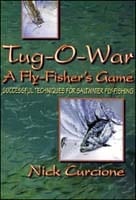
Tug-O-War_1
Review by Steve Raymond
Frank Amato Publications, Inc.
Softcover; $25
You probably know somebody who just can’t ever seem to stop talking. Well, Nick Curcione is sort of like that in print.
In this book, Curcione outlines saltwater fly-fishing basics by means of anecdotal illustrations; in other words, telling fish stories. Even though some of his tales are a bit on the long-winded side, this makes a much more entertaining (and arguably more effective) book than most how-to fishing texts.
Curcione’s first chapter is about rods and reels. He offers good advice on choosing rods and, ”at the risk of raising some folk’s eye-brows,” argues that rods are more important than reels, which he addresses only briefly.
Next is a discussion of lines, loops and leaders, plus a few words on tackle maintenance. A chapter on knots includes step-by-step illustrations of eight knots Curcione suggests every saltwater fly-fisher should know, including the ”most intimidating of all knots,” the Bimini Twist. He eases the intimidation factor by offering an unusually clear explanation of how to tie the Bimini without strangling yourself in the process.
Curcione lists” seven different patterns that have consistently produced for me everywhere I’ve fished.” Most are pictured and accompanied by narrative instructions for tying them.
A chapter on casting assumes most readers already have some casting skill, thus sparing us yet one more eye-glazing attempt to explain the mechanics of fly-casting. Instead, Curcione offers a series of disaster stories in which his or some other anglers’ skills failed to measure up to the occasion, then suggests ways readers can keep such disasters from happening to themselves.
A discussion of ”fly-fishing strategies” includes numerous illustrative tales from Curcione’s seemingly inexhaustible fund of fish stories. Ditto for hook-setting and fish-fighting tactics. Then comes ”reading the water” (logically, shouldn’t that have come first?), with more lengthy tales designed to illustrate his points.
The book concludes with a chapter on auxiliary gear, a discussion of various types of water craft, a welcome ”word on conservation,” and a brief list of products for saltwater fly-fishers.
The text is understandable, but you wouldn’t classify it as literature. However, if you’re willing to make allowances for occasional editing miscues, Curcione’s anecdotal approach makes this book a lot more fun to read than the average instructional fishing to me – and the advice is always helpful and on target.









